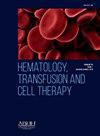EXPERIENCE WITH TOTALLY IMPLANTABLE VENOUS ACCESS PORTS IN PATIENTS WITH HEMATOLOGICAL MALIGNANCIES
IF 1.6
Q3 HEMATOLOGY
引用次数: 0
Abstract
Objective
Totally Implantable Venous Access Ports (TIVAP) are widely preferred for oncology patients requiring chemotherapy.[1] The most common cause of port removal in hematological malignancy patients is infection, followed by dysfunction.[2,3] The aim of this study is to evaluate single center experience of TIVAP in patients with hematologic oncology.
Methodology
126 patients who were followed up in the hematology-oncology department of the tertiary oncology hospital and who had port catheters inserted in the interventional radiology unit between January 2019 ‒ January 2022 was evaluated retrospectively. Post-procedure control radiographs of the patients were evaluated for early complications and localization suitability. Additionally, patients’ port catheter follow-ups were evaluated for infection and dysfunction.
Results
68 (54%) of the patients were male and 58 (46%) were female. The age range of the patients was 18‒65, and the average age was calculated as 41.3. 60 (48%) patients were followed up with a diagnosis of acute myeloid leukemia, 30 (24%) with acute lymphocytic leukemia, 24 (19%) with non-Hodgkin lymphoma, 10 (8%) with Hodgkin lymphoma, and 2 (1%) with multiple myeloma. In the control radiograph examination taken after the procedure, the port location was appropriate in 124 patients and the port catheter ended in the right ventricle in 2 patients. No early complications were observed in any of the patients. Port catheter dysfunction was observed in 8 patients (6%) during follow-up. The average duration of dysfunction development was calculated as 17.25 weeks. Port infection developed in 14 patients (11%) and the average time to develop port infection was calculated as 3.4 weeks. Port infection rates are higher in hematological malignancy patients compared to other malignancy patient groups.
Conclusion
Although the use of port catheters is common in patients with hematological malignancy, caution should be exercised in terms of possible port infection.
全植入式静脉通道在血液系统恶性肿瘤患者中的应用经验
目的全植入式静脉通道(TIVAP)广泛应用于肿瘤化疗患者血液学恶性肿瘤患者最常见的原因是感染,其次是功能障碍。[2,3]本研究的目的是评估TIVAP在血液肿瘤患者中的单中心体验。方法回顾性分析2019年1月至2022年1月在三级肿瘤医院血液肿瘤科随访并在介入放射科植入端口导管的126例患者。术后对照x线片评估患者的早期并发症和定位适宜性。此外,对患者的端口导管随访进行感染和功能障碍评估。结果男性68例(54%),女性58例(46%)。患者年龄18-65岁,平均年龄41.3岁。60例(48%)被诊断为急性髓性白血病,30例(24%)被诊断为急性淋巴细胞白血病,24例(19%)被诊断为非霍奇金淋巴瘤,10例(8%)被诊断为霍奇金淋巴瘤,2例(1%)被诊断为多发性骨髓瘤。术后对照x线片检查124例端口位置合适,2例端口导管止于右心室。所有患者均未出现早期并发症。随访期间,8例(6%)患者出现端口导管功能障碍。功能障碍发展的平均持续时间为17.25周。发生Port感染14例(11%),平均发生Port感染时间为3.4周。血液恶性肿瘤患者的端口感染率高于其他恶性肿瘤患者。结论虽然在血液系统恶性肿瘤患者中使用端口导管是常见的,但应注意可能的端口感染。
本文章由计算机程序翻译,如有差异,请以英文原文为准。
求助全文
约1分钟内获得全文
求助全文
来源期刊

Hematology, Transfusion and Cell Therapy
Multiple-
CiteScore
2.40
自引率
4.80%
发文量
1419
审稿时长
30 weeks
 求助内容:
求助内容: 应助结果提醒方式:
应助结果提醒方式:


